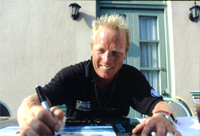 Mike Golding © Photo Billy Black
Mike Golding © Photo Billy BlackThis morning, Golding's boat Team Group 4 was towed into the New Zealand Cup Village. Four days ago Golding hit a sandbar off Cape Reinga. At that time he was the race's overall leader.
 Mike Golding © Photo Billy Black
Mike Golding © Photo Billy Black
Shortly after docking, Golding met the press. "I really thought I was in good shape," Golding said. "I was perhaps 230 miles ahead of my nearest rival. In terms of overall position, it was looking very likely I'd move ahead by one-and-a-half to two days. I had no reason to be cavalier in my approach to the navigation, and as such I didn't feel I was. If there was an error it was an error on my part."
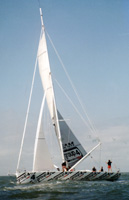 Team Group 4 © Photo Marek Slodownik
Team Group 4 © Photo Marek Slodownik
A helicopter with several photographers was overhead when Golding struck the ground. It
was seen that Team Group 4 struck sandbar at least three times, a fact that Golding
confirmed himself. "Maybe 30 seconds before I hit, I grabbed the helm. I sensed
something being wrong. I steered down and away... But it was too little too late," he
said. As soon as he got clear of the shoal area, Golding said he dropped sail and went
below. "The boat had filled with water in about 7 minutes," he said. "It
did not take a genius to know that we had a big hole." His boat designer Conq said
that the damage was very serious and that the keel could fall off at any moment. At that
point, Golding officially withdrew from Leg 2.
The boat was towed to Auckland, where Golding would haul the boat out and assess the damage. If repairs could be made in time, he would continue on for the final two legs of the event, despite the fact that he would not be eligible for the overall prize.
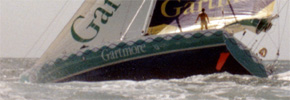 Hall's Gartmore © Photo Marek Slodownik
Hall's Gartmore © Photo Marek Slodownik
His countryman, Josh Hall, was 277 miles out, and was due later this week.
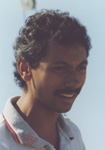 Neal Petersen © Photo Marek Slodownik
Neal Petersen © Photo Marek Slodownik
In Class II, Neal Petersen, who was 2800 miles from Auckland, had some excitement with a
false alarm. He reported: "This morning I got a message from race control to standby
in case I need to divert to Minoru Saito. His EPIRB had been activated, and they were
trying to raise him. I am nearest vessel to him. I plotted his position, worked out a
course if I had to divert, looked at predicted weather and calculate that it would take 20
hours to get to his position. Then a message came back stating it was a false alarm. His
EPIRB had become lose in its bracket & had gotten wet, hence it was activated. Today I
made 189 miles progress towards Tasmania. Because my transom (stern) is so narrow as a
result of lengthening the boat, my vessel is not as directionally stable as the beamy 50
& 60 footers. Steering downwind is like following a meandering stream. I do not have a
quadrant bellow deck, so I cannot fit a big autopilot which could steer in following seas.
This race has been a steep learning curve for the next time round in a new 60 footer. I
wish I was in one already."
At the far end, Robin Davie send a message with his description of passing Kerguelens Islands: "The seas and swells changed considerably last night as we got to the south and into the lee of the Kerguelens. Comparatively small seas, so the continual buffeting and banging of waves into the side of the boat stopped for a few hours, whilst the major heavy Southern Ocean swells continued to barrel up from astern. In some instances the swells were much heightened because of the shallower water and shelf they are running up onto. I didn't see the Islands, it was that sort of dark black night. Had it been clear and moonlit I would almost certainly seen them from 40 miles away as they are glacially mountainous to about 3500 feet, so visible from a long way away. In the previous races I have passed closer by in daylight, and had a great view of the mountain peaks and glaciers. By dawn I was coming out from the lee and the shade of the Islands, so it didn't take long for the beam seas to build again, which together with an increasing wind which became more northerly was soon giving me a rougher ride again."
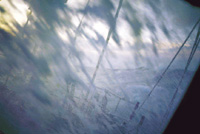
© Photo Richard Konkolski
Place |
Skipper |
Boat |
Latitude |
Longitude |
Dist. to go |
Speed |
Dist. to first |
Time |
1 |
Soldini |
Fila |
Auckland |
0 |
0 |
0 |
0 |
0 |
2 |
Thierceli |
Somewhere |
Auckland |
0 |
0 |
0 |
0 |
0 |
3 |
Autissier |
PRB |
Auckland |
0 |
0 |
0 |
0 |
0 |
4 |
Hall |
Gartmore |
35 30S |
171 03E |
277 |
9 |
276.8 |
2140 |
5 |
Konioukhov |
Mod.Univ.Human. |
46 01S |
098 13E |
3539 |
4.7 |
3538.5 |
2140 |
6 |
Golding |
Team Group 4 |
Retired |
Auckland |
0 |
0 |
0 |
0 |
Place |
Skipper |
Boat |
Latitude |
Longitude |
Dist. to go |
Speed |
Dist. to first |
Time |
1 |
Mouligne |
Cray Valley |
Auckland |
0 |
0 |
0 |
0 |
0 |
2 |
Garside |
Magellan Alpha |
38 32S |
165 57E |
582 |
8.6 |
581.7 |
1949 |
3 |
Van Liew |
Balance Bar |
38 32S |
164 46E |
628 |
8.6 |
628.4 |
1544 |
4 |
Yazykov |
Wind of Change |
40 27S |
159 01E |
917 |
8.2 |
917.3 |
1544 |
5 |
Saito |
Shuten-dohji II |
45 30S |
124 17E |
2459 |
6.1 |
2459.1 |
1544 |
6 |
Petersen |
No Barriers |
46 06S |
121 03E |
2593 |
5.9 |
2593.1 |
1544 |
7 |
Hunter |
Paladin II |
45 07S |
113 10E |
2928 |
5.5 |
2927.9 |
1544 |
8 |
Davie |
South Carolina |
50 11S |
077 20E |
4342 |
3.6 |
4341.6 |
1544 |
9 |
Stricker |
Rapscallion III |
Retired |
0 |
0 |
0 |
0 |
0 |
Copyright © Richard Konkolski
Return back to Second Leg
Return back to First Leg
Retyrn back to Sailing Round the World Races
Return back to Seven Oceans